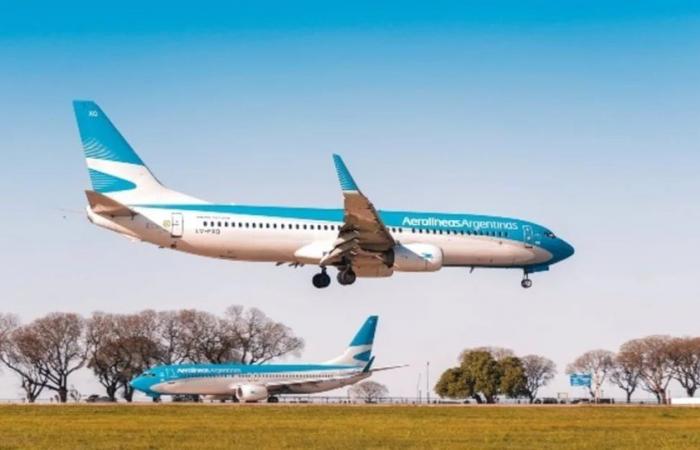
Aerolíneas Argentinas plans to reduce its deficit by 50% in 2024 by making its operations more efficient, adjusting frequencies to demand and increasing its income. In addition, agreements are being made with municipalities to guarantee minimum occupancy on flights in some locations.
The flag airline was one of the three public companies that the Executive agreed to leave out of the privatization chapter of the Bases Law to guarantee votes in the Senate. Now the ruling party will insist on privatizing it in the Deputies, since the project returns to the Lower House and the legislators will decide whether to accept the modifications or insist on the original text of the half-sanction.
In the event that he does not succeed, the presidential spokesperson, Manuel Adorni, in his usual press conference, said: “It is likely that Airlines will stop flying to certain provinces because they are unprofitable, but in such case it will be a decision made by those who understand routes and aeronautical issues themselves. Clearly the path is for Aerolíneas Argentinas, while it remains in the hands of the State, to lose less and less money. “This is going to happen with all companies that are in the hands of the State and that are not privatized.”
Company sources assured Infobae that in 2023 they lost USD 390 million and this year it aims for it to be less than half. They specified that of that amount, around USD 190 million was lost between April and June (low season) since the supply of flights remained constant without adjusting for demand.
“This year we adjusted the supply to match real demand. So we are already having significant savings and that is what will allow us to reduce the deficit. Moving forward, we are not going to continue cutting frequencies. In fact, now in high season we are going to increase them. The July offer will be the same or even a little higher than that of July last year,” they explained from Aerolíneas.
In this regard, starting next month, the supply of seats will reach 1,114,000 seats in the domestic market. Meanwhile, more than 180 thousand passengers are expected on the international network and on the main regional routes, about 15% more than those transported last year.
Likewise, the aim is to improve income and not implement a generalized cutback policy. Between October and September the routes will be resumed: Bariloche – El Calafate, Córdoba – El Calafate, Córdoba – Trelew, Rosario – El Calafate, Trelew – El Calafate, and Trelew – Ushuaia. Also, in the coming months two new flights will be inaugurated from Córdoba to Rio de Janeiro and Punta Cana, and double daily flights to Miami and Madrid. These are decisions that have to do with the new income generation opportunities that the company detects.
“It is not always a question of cutting back, but rather of improving income. That is the other angle from which the problem is attacked,” they noted.
“It is an industry that works a lot on efficiency and we must look for points where income can be improved in the three networks, both cabotage and regional and international. It is often misunderstood and it is thought that flights are going to be cut on all the routes they lose. Whether a route loses or gains money is relative because there are some that do not work very well, but that serve as traffic collectors for routes that do, that drive to other destinations,” they clarified.
In this sense, they argued that a route cannot be eliminated because it loses money over a period of time because there are many influencing factors, such as seasonality. “There is no general policy of cutting routes. Airlines’ problems are not solved like this,” they added.
On the other hand, agreements are being made with municipalities to guarantee a minimum occupancy during the low season. In this way, the risk of whether the flight works or not is shared. Local governments worry about encouraging demand or pay for a passenger floor. This is the model that is being applied in Río Cuarto to avoid eliminating the route and Aerolíneas affirms that it is working well. It has already been offered to other provinces that were demanding more frequencies and many are studying it.





